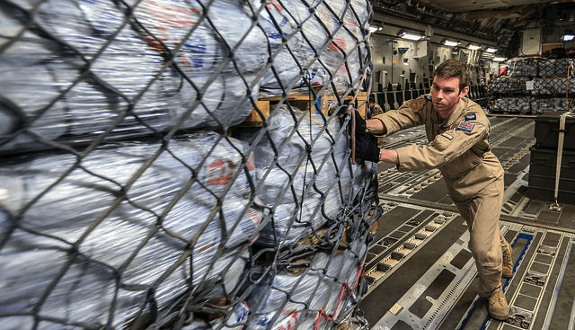Nepal’s New Prime Minister Faces Herculean Tasks
A military plane is unloaded in Kathmundu, Nepal on 29 April 2015 delivering UK aid © Sgt Neil Bryden/RAF (CC BY 2.0)
A new constitution, a virtual embargo by its neighbor India, deadly clashes between police and protesters and the recovery from the earthquakes in April and May 2015. Nepal’s newly elected Prime Minister K.P. Sharma Oli is taking office in a turbulent situation.
Following the passing of the new constitution in September of last year, the first of its kind in Nepal that was decided on by a democratically chosen assembly, Nepal’s parliament has elected Sharma Oli as prime minister on 11 October 2015. Oli is now faced with a herculean task: post-quake recovery, reconciliation between casts and mitigating tensions with the giant in the South, India, are all on the agenda. Above all, Oli has to finally propel the Himalayan country out of its status as one of the least developed countries in the world.
International donors pledged more than $4 billion to aid the recovery effort after two devastating earthquakes. Nepal has been a recipient of development aid for decades, but past and present experience has made donors and the country’s population wary.
Since 2005, official development assistance (ODA) averaged 34% of all government expense. This has not yielded any promising results, at least as far as the economy is concerned. Nepal remains one of the poorest and least developed countries in the world. With a per capita GNI of $730, Nepal ranks 145th out of 188 countries in the 2015 Human Development Index (HDI).
Since the end of the Maoist insurgence in 2006, governance has been poor. The Bertelsmann Transformation Index (BTI), a governance assessment tool covering 129 countries, rated Nepal at 3.0 and 3.3 on a 1-10 scale in the indicators “resource efficiency” and “steering capability” in 2014. The country clearly lacks a coordinated long-term approach for economic growth. All of the above suggests that aid in Nepal is ineffective, misused and wasted.
Some bright spots on the horizon
The forthcoming BTI, to be published in February 2016, however, projects a nuanced image of the effectiveness of foreign aid. Nepal receives a respectable score of 6 in the indicator “effective use of (international) support”. The same index rates Nepal at a mere 3 in the indicator “efficient use of (domestic) assets”. Apparently, Nepal is more successful in using international assistance for its own development agenda than it is able to efficiently use human, financial and organizational resources at home.
From 2005 to 2012, around 12% of all ODA went to the health sector, and, according to the World Bank, between 40 and 50% of total government expenditure on health consisted of ODA. The education sector attracted an even larger share of ODA (17%).
Between 2000 and 2013, Nepal has reduced its under-five mortality rate by more than half, down to 40 per 1,000 live births. Life expectancy at birth has increased from 62 to 68 years. Literacy rate of people aged between 15 and 24 stands at 86% in 2015, displaying significant progress from the figure of 70.1% in 2000. Equally encouraging, Nepal pushed its primary school enrolment rate up to 98% and primary completion rate was at 100% in 2014.
Nepal’s government embraced the aims of the Millennium Development Goals and shaped its development policies in direct endorsement of all eight goals. It implemented the Aid Management Platform in an attempt for more transparency and aid effectiveness.
These measures have borne fruit. The upcoming Bertelsmann Transformation Index points out that in association with a large host of international partners Nepal has produced ”good results, especially in the areas of education, health, drinking water, telecommunications, road construction and power generation.”
However, the slow government response to the two earthquakes that struck Nepal last April and May jeopardizes the recent progress in human development. It took the government nearly two months to set up the National Reconstruction Authority (NRA) which has since been disbanded, because parliament failed to ratify a bill required for the NRA to start helping the earthquake victims. Consequently, as of September the government had yet to access the international aid. The sluggish earthquake recovery has led to many frustrations among ordinary Nepali citizens.
“Like we are not Nepali”
Especially in the plain Terai region bordering India frustrations are mounting. “Like we are not Nepali” has become a popular slogan among protesters who are dissatisfied with the quickened pace that led to the constitution. Nepalese living in the plains, mostly Madhesis and Tharus, feel marginalized by the constitution which they argue regards them as second-class citizens. According to Human Rights Watch, 45 people have died in protests in August and September last year.
The situation at hand – corruption, mishandling of the post-quake recovery, the protests following the constitution – and the virtual embargo imposed by India provide a bleak outlook for Nepal’s immediate future. India, which, according to Nepali officials, covertly supports protests in the border region and additionally prevents the supply of fuel and other goods to cross into the landlocked country, denies these accusations.
However that may be, the situation has led to a dramatic fuel shortage in Nepal and cost the country’s economy more than $1 billion. Despite the uncertainty, past success in spreading education and improving the health situation of Nepal’s citizens should propel donors to further engage in the Himalayan country. Prime Minister Oli has to plan for the long-term, he has to limit bad governance and rent-seeking, while also addressing the continuous stagnation on the socioeconomic front. But he will have a hard time doing that without the help of the international community and Nepal’s regional neighbors.
Marvin Jérôme Hanke is research assistant at the Bertelsmann Stiftung’s Transformation Index (BTI). He studied Political Science and English at Bielefeld University and the University of Zurich.
Related BTI
Study: BTI 2014 Report
Political Management in International Comparison
